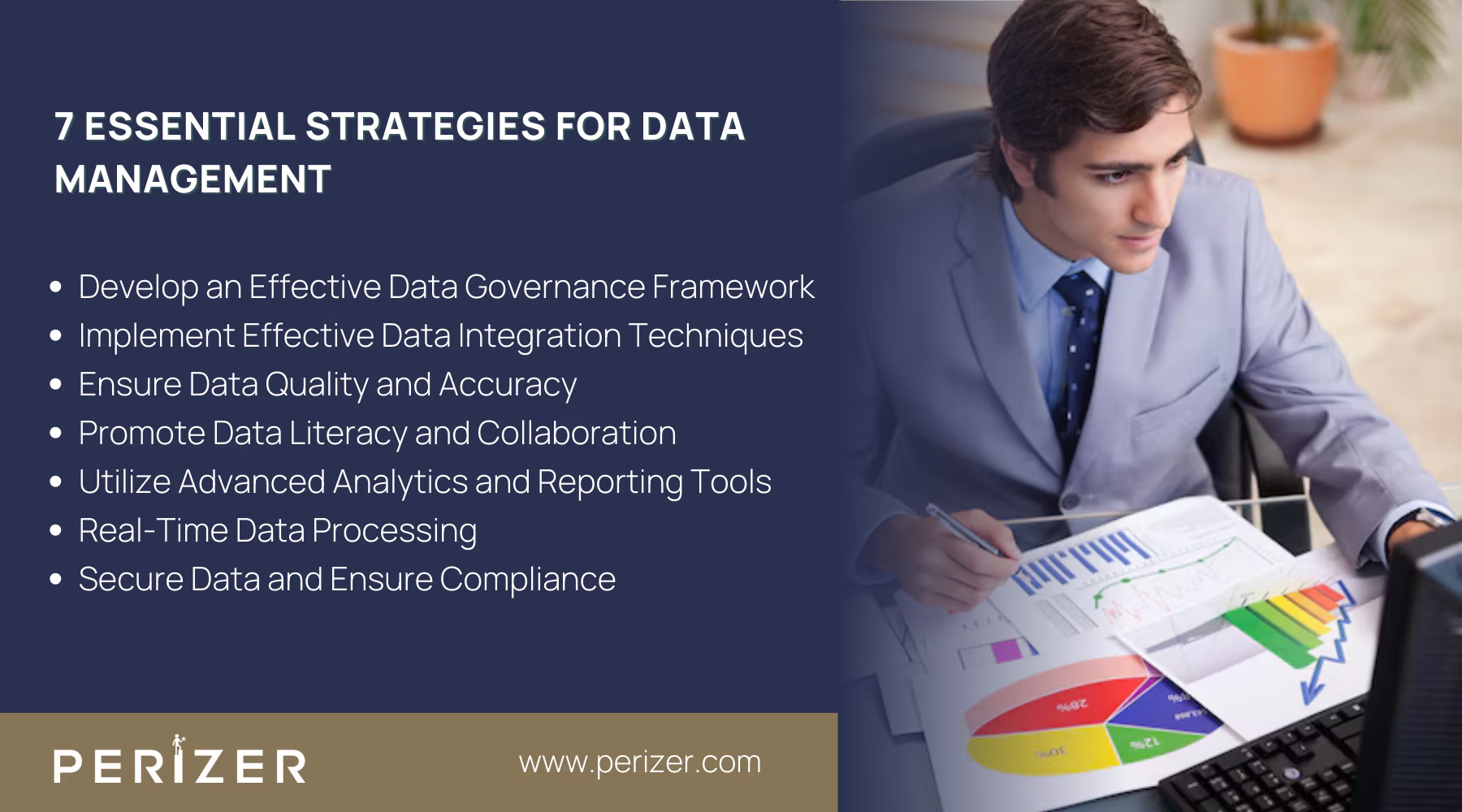7 Essential Strategies for Data Management Mastery
Discover seven essential strategies for mastering data management. Learn to enhance governance, integration, and quality for a competitive edge.

Effectively managing data is no longer a technical requirement; it’s becoming a strategic necessity. If you’re managing the complexities of a growing organization, you understand that data management is important for operational efficiency and business success. Data isn’t just something you store; it’s the foundation of every decision you make. But to truly use its power, you need to master strategies that allow you to manage data with expertise and insight.
Mastering data management is about more than having the right resources. It’s about aligning those strategies with your business goals, ensuring data integrity, and extracting maximum value from every piece of information.
In this guide, we'll cover seven essential strategies to help you master data management, refine your practices, and keep your edge in the market.
7 Essential Strategies for Data Management

1. Develop an effective Data Governance Framework
Data governance forms the foundation of any effective data management strategy. It’s not just about setting rules it’s about ensuring that everyone in your organization understands and respects the data lifecycle. Without a strong governance framework, even the best data can become a liability.
Establish Clear Roles and Policies
Start by assigning data managers who will be responsible for maintaining the accuracy and integrity of specific datasets. These managers are key players in your data ecosystem, ensuring that data is consistent, reliable, and used appropriately. Develop comprehensive policies that cover every aspect of data management from collection and storage to access and usage. These policies should align with industry regulations like GDPR, HIPAA, or CCPA to ensure compliance and protect your organization from potential risks.
Regular audits and compliance checks are essential to maintain the effectiveness of your governance framework. By continually reviewing and updating your policies, you ensure that your organization remains agile in the face of regulatory changes and evolving business needs. A powerful governance framework not only minimizes risks but also promotes a culture of data responsibility, building trust with customers and stakeholders.
2. Implement Effective Data Integration Techniques
In most organizations, data is spread across multiple systems, databases, and even spreadsheets. The challenge is not just collecting this data, but integrating it to make it accessible, consistent, and ready for analysis. Effective data integration is important for creating a consistent view of your organization’s information.
Implement ETL processes and centralize storage
Start by using ETL (Extract, Transform, Load) processes. These steps help you collect data from different sources, clean it up, and standardize it before storing it in a central location, like a data warehouse or data lake. During the extraction phase, you gather data from various systems, whether it’s your CRM, ERP, or external sources. The transformation phase is where you clean the data—removing duplicates and fixing errors to ensure everything is consistent. Finally, in the loading phase, the clean data is stored in a way that makes it easy to access and analyze.
Using real-time data integration tools can make this process even better by keeping your data up-to-date. This allows for quicker, more accurate decisions. By breaking down data silos and creating a single, reliable source of truth, your teams can make informed decisions that drive success for your business.
3. Focus on Data Quality Management
High-quality data is the foundation of effective data management. Without it, even the most advanced analytics tools are rendered useless. Poor data quality can lead to misguided decisions, inefficiencies, and lost opportunities.
Automate Data Cleansing and Standardization
To maintain data quality, implement automated cleansing processes that regularly scan your datasets for duplicates, errors, and inconsistencies. These automated tools detect and correct errors such as duplicate entries or incorrect formats, ensuring that your data remains accurate and usable.
Standardizing data formats and definitions across your organization is also important. Consistency in how data is labeled, formatted, and stored makes it easier to integrate, analyze, and share across departments. By setting and enforcing data quality standards, you prevent issues before they arise, ensuring that your data is always reliable.
Data quality management isn’t just about fixing problems it’s about prevention. Establishing data validation rules at the point of entry helps catch errors before they become fixed in your system.
Regular training for your team on best practices for data entry and management further supports this effort and promotes a culture of accuracy and responsibility. High-quality data builds trust within your organization and with external stakeholders, ensuring that the insights you derive are both actionable and trustworthy.
4. Implement Scalable Data Storage Solutions
As your business grows, so does the amount of data you need to manage. Relying on outdated or inflexible storage solutions can lead to performance bottlenecks, increased costs, and even data loss. Scalable storage solutions are essential for accommodating growth without sacrificing performance or accessibility.
Utilize Cloud-Based and Hybrid Storage Options
To adopt scalable storage solutions, look to cloud-based platforms that offer flexible, on-demand storage capabilities. Cloud services like AWS, Google Cloud, or Azure allow you to expand storage as needed, without significant upfront investments in physical infrastructure. This scalability is especially valuable as it provides built-in redundancy and disaster recovery, ensuring that your data is protected even in the event of hardware failure or other disruptions.
For organizations that handle sensitive data, hybrid storage solutions offer the best of both worlds by combining the scalability of cloud storage with the security of on-premises systems. Important data can be stored locally, while less sensitive information is housed in the cloud. This approach provides flexibility while maintaining control over your most important assets.
Implementing tiered storage strategies can also optimize costs. Frequently accessed data is stored on high-performance media, such as solid-state drives (SSDs), while less critical data is stored on more cost-effective storage, such as traditional hard drives or cloud storage. This ensures that your most important data is always accessible when you need it, without the high costs associated with storing all your data on expensive media. Scalable storage solutions allow your data infrastructure to grow alongside your business, ensuring that you remain agile and competitive.
5. Utilize advanced analytics and artificial intelligence
Collecting and storing data is only the beginning. The true value of data lies in the insights it can provide, and advanced analytics and AI are the tools that unlock this potential. These technologies enable you to uncover patterns, predict trends, and make data-driven decisions that give you a competitive edge.
Integrate AI to Improve Decision-Making
To use advanced analytics, start by incorporating machine learning and AI tools into your data management strategy. These tools can process vast amounts of data quickly, identifying correlations and patterns that might be missed by human analysts. For instance, predictive analytics can help you forecast market trends or customer behavior, allowing you to make proactive decisions that anticipate rather than react to changes.
AI-driven tools can also automate routine data analysis tasks, freeing up your team to focus on more strategic activities. For example, AI algorithms can automatically categorize and tag data, making it easier to search and analyze. They can also identify anomalies in your data, alerting you to potential issues before they escalate.
The integration of AI into your analytics processes not only enhances your decision-making capabilities but also improves the speed and accuracy with which decisions are made. This allows your organization to stay ahead of the curve, using data not just to understand the past, but to predict and shape the future.
6. Ensure Data Security and Privacy
With the rise of cyber threats, securing your data has never been more important. Beyond the financial risks, a data breach can damage your reputation and destroy customer trust. Powerful data security measures are important for protecting your organization and its stakeholders.
Implement Comprehensive Security Protocols
Start by encrypting your data both at rest and in transit. Encryption ensures that even if data is intercepted, it cannot be easily accessed or used by unauthorized parties. Implement role-based access controls to limit who can view or edit sensitive information, ensuring that only those with a legitimate need have access.
Regularly update your security protocols to protect against evolving threats. Conduct vulnerability assessments and penetration testing to identify and address potential weaknesses in your system. Compliance with regulations such as GDPR, HIPAA, or CCPA is also important your data management practices should reflect the firm standards of security and privacy.
Employee training is another important component of data security. Regularly educate your team on the latest security best practices, ensuring they understand the importance of protecting sensitive information. By fostering a culture of security awareness, you reduce the risk of human error, which is often the weakest link in data protection.
7. Promote a Data-Driven Culture
Even with the best tools and strategies, the true power of data can only be used in a culture that values and utilizes data in decision-making. Promoting a data-managed culture means ensuring that data is central to your organization’s strategic initiatives and daily operations.
Promote Collaboration and Data Literacy
To create a data-driven culture, start by improving data literacy throughout your organization. Offer training and resources to help employees understand how to use data effectively. This training should cover not only technical skills but also how to apply data for strategic decisions and achieving business goals.
Encourage teamwork between data experts and other departments. When different teams collaborate and share insights, they can use data to tackle challenges and drive innovation. Implement easy-to-use dashboards and reporting tools to make data accessible to everyone, so employees can make informed decisions without needing constant IT support.
Lead by example by incorporating data into all strategic decisions. When leadership emphasizes data management choices, it sets a standard for the entire organization. Over time, this approach integrates data into your company’s core processes, making dependence on data insights a fundamental part of achieving success.
Conclusion
Mastering data management isn't just about having the right technology - it's about taking a thoughtful approach that fits with your business goals and grows with you as your needs change. By focusing on how to effectively apply these seven essential strategies, you can transform data management from a routine task into a major competitive advantage. Building a strong governance framework and utilizing advanced analytics are just a few critical steps to ensure your data is both well-managed and optimized for success.
As you start applying these strategies, remember that mastering data management depends on the details. It’s about putting in consistent effort, making regular updates, and nurturing a culture that values data. These practices will help your organization stand out.
FOCUSED, FAST, GOVERNMENT READY
Stay Tuned With Our Latest Insights

Staff Augmentation
Learn how to select the perfect IT outsourcing partner to promote your team’s capabilities, improve productivity, and drRead more...

Staff Augmentation
Find the perfect staff augmentation partner by aligning your goals, evaluating expertise, managing costs, and ensuring aRead more...

Cyber Security
We focus on understanding the needs, behaviors, and expectations of your users through extensive user research. This infRead more...